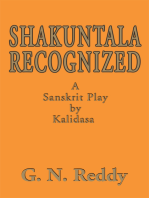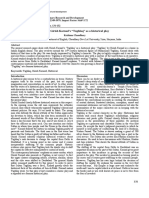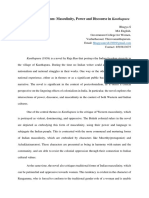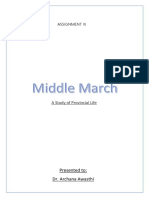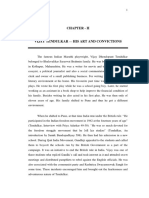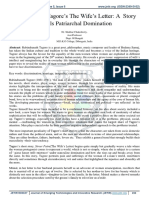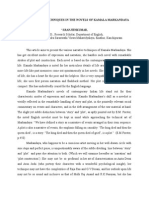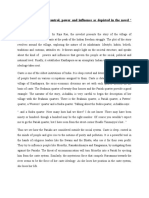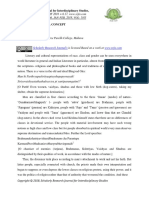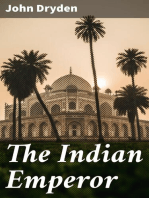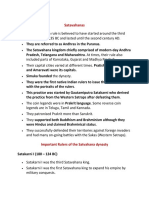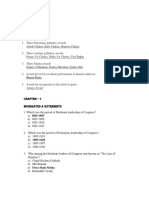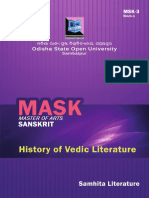Tughlaq
Tughlaq
Uploaded by
Sameer MayekarCopyright:
Available Formats
Tughlaq
Tughlaq
Uploaded by
Sameer MayekarCopyright
Available Formats
Share this document
Did you find this document useful?
Is this content inappropriate?
Copyright:
Available Formats
Tughlaq
Tughlaq
Uploaded by
Sameer MayekarCopyright:
Available Formats
LANGUAGE IN INDIA
Strength for Today and Bright Hope for Tomorrow
Volume 12 : 4 April 2012
ISSN 1930-2940
Managing Editor: M. S. Thirumalai, Ph.D. Editors: B. Mallikarjun, Ph.D. Sam Mohanlal, Ph.D. B. A. Sharada, Ph.D. A. R. Fatihi, Ph.D. Lakhan Gusain, Ph.D. Jennifer Marie Bayer, Ph.D. S. M. Ravichandran, Ph.D. G. Baskaran, Ph.D. L. Ramamoorthy, Ph.D.
A Perspective on Symbols in Girish Karnads Tughlaq
M. Jagadeswari, M.A., M.Phil., Ph.D. Scholar
=================================================================
Abstract Imagination creates culture out of nature and it also produces literary language. Symbols are often used to support a literary theme in a subtle manner. Symbol is something that represents something else either by association or by resemblance. The purpose of symbol is to Language in India www.languageinindia.com 12 : 4 April 2012 M. Jagadeswari, M.A., M.Phil., Ph.D. Scholar A Perspective on Symbols in Girish Karnads Tughlaq
100
communicate meaning. Girish Karnad is the foremost playwright of modern India. Tughlaq, his second play, is a historical play replete with symbolism. Tughlaq A Symbolic Play Girish Karnad in Tughlaq deals with the life of the medieval Indian ruler, Muhammad Bin Tughlaq. The author skillfully picturises the life and reign of Tughlaq through his intensive use of symbols. Girish Karnad in Introduction to Three plays remarks: Muhammad the mad the Sultan ended his career in blood sheds and political chaos. In a sense, the play reflected the slow disillusionment my generation felt with the new politics of independent India, the gradual erosion of the ethical norms that had guided the movement for independence, and the coming to terms with cynicism and real politik.(27) In the play, the symbols have a myriad of origin as well as forms. He used symbols to represent universal thoughts and emotions. His use of various symbols in the play such as Chess, Aziz and Aazam, Prayer, Python, Daulatabad, Rose and birds like Vulture add greater emotional and associative significance. Chess Tughlaq is a skillful chess prayer. He plays the game of chess not as a pastime but as a means of solving complicated problems. Muhammad says, I have just solved the most famous problem in chess. Even al-Adli and as-Sarakhi said it was insoluble. And its so simple- (Karnad,Tughlaq 9;sce.2). The game of chess symbolizes Tughlaqs high manipulative skill of dealing with political rivals and opponents. Tughlaq considers his critics and enemies merely as pawns of chess which he can use at his will. Tughlaq well plays the chess of politics and solves the problem created by Ain-ul-Mulk and Sheikh Imam-ud-din. He uses Sheikh Imam-ud-din as his pawn to solve the problems of Ain-ul-Mulk. Ain-ul-Mulk, the friend of Tughlaq revolts against him and is marching towards Delhi. Sheikh by his constant speech enlightens the people and is inciting rebellion against Tughlaq in Kanpur. Sheikh Imam-ud-din resembles Tughlaq in appearance. Tughlaq crafts a plan. He invites Sheikh to Delhi and cunningly sends him to Ainul-Mulk as his envoy of peace in the royal robes. The dress makes them look alike. In the battlefield, Sheikh is killed. Thus Tughlaq craftly overthrows the fighter of Islam. Ani-ul-Mulk is pardoned and is made the governor of Avadh. The chess symbol symbolizes that the whole kingdom is as complicated and full of problems as the game of chess. P. Bayapa Reddy remarks: At the macro level, the game of chess is an ordinary game, which is popular in India. It also symbolizes a political game in which the most intelligent and clever politician is check mated by an ordinary washerman. Through this symbolist technique, the playwright has Language in India www.languageinindia.com 12 : 4 April 2012 M. Jagadeswari, M.A., M.Phil., Ph.D. Scholar A Perspective on Symbols in Girish Karnads Tughlaq
101
succeeded in creating the right political atmosphere.(155) Aziz and Aazam The criminals like Aziz and Aazam symbolize unprincipled and opportunistic exploits of people. They exploit the liberal ideas and policies and the welfare activities of the government. They lack humanity and utilizes every chance to earn money. Aziz, the dhobi, disguises as Brahmin Vishnu Prasad and wins the case against the Sultan himself. To Aziz politics is a profitable profession. Aziz remarks to Aazam: My dear fellow, thats where our future is politics! Its a beautiful world-wealth, success, position, power- and yet its full of brainless people, people with not an idea in their head. (Karnad, Tughlaq 50;sce.7). He murders Ghiyas-ud-din Abbasid and in the guise of the saint, appears before the sultan to bless him and purify Daulatabad. Aziz the wily timeserver appears to represent all those who took advantage of Sultans visionary schemes and fooled him. The corrupt people like Aziz and Aazam symbolize who took bribes and undue favours from the king. Prayer Prayer symbolizes the fact that the life of Tugfhlaq is full of corruption. The Amirs, some courtiers, Sheikhs, led by Ratan Singh and Shihab-ud-din conspire to kill the Sultan at the time of prayer. The plan is exposed by Ratansingh to Sultan and Shihab-ud-din is cunningly killed by Sultan. U.R. Anantha moorthy mentions, The use of prayer for murder is reminiscent of what Tughlaq himself did to kill his father. That prayer, which is most dear to Tughlaq, is symbolic of the fact that his life is corrupted at its very source(ix). Sultan is fanatic about prayer. He realizes the futility of prayer and prohibits prayer in his kingdom. The ban is revoked only after five years when Ghiyas-ud-din Abbasid comes to Daulatabad to bless the Sultan. Prayer is exploited as an instrument of murder. The word prayer has lost its relevance in the play. In the words of P. Bayapa Reddy: At the micro level, prayer symbolizes the religious idealism of Tughlaq. At the macro level, it connects mans unconscious need for divine protection and guidance in an hour of anguish. In the beginning, prayer is made compulsory but later it is revived. It is reduced to a mockery when the Sultans life is threatened at the time of prayer.(155)
Python The fort has a long and dark passage coiled like an enormous hungry python inside its belly. The python kills its prey by twisting itself round and crushing it. Similarly, any living creature enters the fort is crushed and swallowed. When the young man pries about the fort the old man says, yes, its a long passage, a big passage, coiled like an enormous hollow python inside the belly of the fort. (Karnad, Tughlaq 52;sce.8). The python symbolizes Tughlaqs cunning and crooked tricks with which he traps those who rebel against him. The python Language in India www.languageinindia.com 12 : 4 April 2012 M. Jagadeswari, M.A., M.Phil., Ph.D. Scholar A Perspective on Symbols in Girish Karnads Tughlaq
102
symbolizes increasing fierceness, brutality, blood thirstiness and inhuman nature of Tughlaq. The python is symbolic of complete degeneration of the personality of Tughlaq. Vulture The frustration mood of Tughlaq is symbolized by vultures. It is symbolic that vultures in the form of rebels thrust their beaks into the flesh of Muhammad and has made him to lose all his peace. Mohammad in dejection mood says, Dont you see- This patient, racked with fever and crazed by the fear of the enveloping vultures, cant be separated from me ?... (Karnad, Tughlaq 56; sce.8). The vultures also symbolize Tughlaqs ideas, ambitions, and desire of revenge. They do not allow him any peace day and night. He is known as a mad emperor. Daulatabad Daulatabad city is a Hindu city. Tughlaq wants to flourish Muslim culture there. It is a symbol of Hindu-Muslim Unity. It throws light on the mistrust that is emerging amongst the Hindus and Muslims in Tughlaqs rule. The old man feels as he is trapped in an eagles nest (Karnad, Tughlaq 51; sce.8). It shows the collapsed life of the people. It symbolizes the rash and uncalculated decisions of Tughlaq. Rose Sultan is a learned man. He is so deeply influenced by the beautiful poems of Sheikh Sadi of Persia. He plans a beautiful rose garden. Later on, the garden is heaped only with the counterfeit coins minted in his kingdom. When Muhammad tells his step-mother about the decision of heaping the counterfeit coins in the rose garden, it can be noted: STEP-MOTHER: Whats wrong with you: You spent years planning that rose garden and nowMUHAMMAD: Now I dont need a rose garden, I built it because I wanted to make for myself an image of Sadis poems. I wanted every rose in it to be a poem. I wanted every thorn in it to prick and quicken the senses. But dont need these airy trppings now ; a funeral has no need for a separate symbol. (Karnad, Tughlaq 63-64;sce.10) The rose garden the king envisages is the garden of ideals which has dried by towards the end. P.Bayapa Reddy remarks: The rose is a symbol of the aesthetic and poetic susceptibilities of Tughlaq. It later on becomes a symbol of the withering away of all the dreams and ideas of Tughlaq (155). Tughlaq Language in India www.languageinindia.com 12 : 4 April 2012 M. Jagadeswari, M.A., M.Phil., Ph.D. Scholar A Perspective on Symbols in Girish Karnads Tughlaq
103
The play Tughlaq is itself symbolic. It is not only historical but can be seen as a symbol of the contemporary political situation in India. Tughlaq reflects the chaos, disillusionment and prevailing corruption in independent India. The Indian governments policies are echoed by those of Tughlaq. U.R. Anantha Moorthy comments, It is a play of the sixties, and reflects as no other play perhaps does the political mood of disillusionment which followed the Nehru era of idealism in the country (vii-viii). Conclusion Girish Karnad has used relevant symbols in an effective way to enrich its beauty. It helps to understand the theme in a realistic way.
==================================================================== Works Cited Karnad, Girish. Tughlaq. Delhi: Oxford University Press, 2011. Print. Karnad, Girish. Introduction to Three Plays. The Plays of Girish Karnad. Ed. Jaydipsingh Dodiya. New Delhi: Prestige, 1999. 21-37. Print. Murthy, Anantha U.R.Introduction. Tughlaq. By Girish Karnad. Delhi : Oxford University Press, 2011. vii-x . Print. Reddy, Bayapa.P. The Theatrical Representation of History. The Plays of Girish Karnad. Ed. Jaydipsingh Dodiya. New Delhi: Prestige, 1999. 149-55. Print ============================================================= M. Jagadeswari, M.A., M.Phil., Ph.D. Scholar Assistant Professor of English Vellalar College for Women (Autonomous) SF Erode 638012 Tamilnadu India mahijagi@gmail.com
Language in India www.languageinindia.com 12 : 4 April 2012 M. Jagadeswari, M.A., M.Phil., Ph.D. Scholar A Perspective on Symbols in Girish Karnads Tughlaq
104
You might also like
- O4 Hope and Despair: A Fine BalanceDocument31 pagesO4 Hope and Despair: A Fine BalanceAaryan Nayak100% (2)
- Discuss Girish Karnad's "Tughlaq" As A Historical PlayDocument2 pagesDiscuss Girish Karnad's "Tughlaq" As A Historical PlayPunyo SarmingNo ratings yet
- KARUKKUDocument5 pagesKARUKKUManoj KumarNo ratings yet
- Options Basics 01Document52 pagesOptions Basics 01sam2004No ratings yet
- "Swimming Lessons" by Rohinton MistryDocument5 pages"Swimming Lessons" by Rohinton MistryEeshitaNo ratings yet
- The Calcutta Chromosome: A Kind of Mystery ThrillerDocument33 pagesThe Calcutta Chromosome: A Kind of Mystery ThrillerAmarendra Kumar AvinashNo ratings yet
- The Dalit Theatre (Rangbhoomi) in MaharashtraDocument5 pagesThe Dalit Theatre (Rangbhoomi) in Maharashtraharesh1883No ratings yet
- xINTRODUCING LITERATURE ENG1B01 PDFDocument65 pagesxINTRODUCING LITERATURE ENG1B01 PDFAneeshya Sunil100% (1)
- My Childhood Textual Exercises PDFDocument17 pagesMy Childhood Textual Exercises PDFKanhaiya GutteNo ratings yet
- Poisoned Bread Translations From Modern Marathi Dalit Literature (Arjuna Dangale) - 15-19Document5 pagesPoisoned Bread Translations From Modern Marathi Dalit Literature (Arjuna Dangale) - 15-19ANKIT KUMAR DUBEYNo ratings yet
- P B ShellyDocument60 pagesP B ShellyStudy GuideNo ratings yet
- Vi Desse LieDocument4 pagesVi Desse LieRahul KumarNo ratings yet
- Critical Reading - ChugtaiDocument20 pagesCritical Reading - ChugtaiMuhammad NumanNo ratings yet
- Anna Akhmatova and Her PoemsDocument8 pagesAnna Akhmatova and Her Poemsabhijit8sarkar-3No ratings yet
- 13 - Chapter 7 PDFDocument27 pages13 - Chapter 7 PDFAtul Ranjan100% (1)
- Analysis of KanthapuraDocument7 pagesAnalysis of KanthapuraBhagya SNo ratings yet
- 10 - Chapter 3 PDFDocument37 pages10 - Chapter 3 PDFAbhay HariNo ratings yet
- Karnad's Tughlaq As An Alienated ProtagonistDocument43 pagesKarnad's Tughlaq As An Alienated ProtagonistDonet M Thomas67% (6)
- English Paper IIIDocument52 pagesEnglish Paper IIIGuruKPONo ratings yet
- Allusions in Lamb's EssayDocument2 pagesAllusions in Lamb's EssayManish Kumar DubeyNo ratings yet
- Unheard Voices of The Voiceless: Analysing Hansda Sowvendra Shekhar's The Adivasi Will Not DanceDocument4 pagesUnheard Voices of The Voiceless: Analysing Hansda Sowvendra Shekhar's The Adivasi Will Not DanceIJELS Research JournalNo ratings yet
- Presented To: Dr. Archana Awasthi: A Study of Provincial LifeDocument7 pagesPresented To: Dr. Archana Awasthi: A Study of Provincial LifeJaveria MNo ratings yet
- 05 - Chapter1 (Indo-English Literature) PDFDocument71 pages05 - Chapter1 (Indo-English Literature) PDFAnonymous 9hu7fl100% (1)
- Augustan AgeDocument35 pagesAugustan AgeLify BlessyNo ratings yet
- Unveiling The Veil: Critical Study of The Two Poems "Purdah I &II" of Imtiaz DharkerDocument10 pagesUnveiling The Veil: Critical Study of The Two Poems "Purdah I &II" of Imtiaz DharkerShibashish MahapatraNo ratings yet
- Chapter - IiDocument32 pagesChapter - IiKapil MilhotraNo ratings yet
- MA ENGLISH PreviousDocument25 pagesMA ENGLISH PreviousRadheShyam SharmaNo ratings yet
- Derozio 1Document15 pagesDerozio 1LuminaNo ratings yet
- Rabindranath Tagore's The Wife's Letter: A Story Reveals Patriarchal DominationDocument4 pagesRabindranath Tagore's The Wife's Letter: A Story Reveals Patriarchal DominationManoj JanaNo ratings yet
- We Should All Be FeministsDocument9 pagesWe Should All Be FeministsDaniel BatlaNo ratings yet
- Indian English Literature: SemesterDocument104 pagesIndian English Literature: Semesterpsgnanaprakash8686No ratings yet
- Midaq Alley ReviewDocument3 pagesMidaq Alley ReviewAulia Rizal RohmahNo ratings yet
- Shalini JainDocument22 pagesShalini JainNasrullah MambrolNo ratings yet
- The Narrative Techniques in The Novels of Kamala Markandaya: J.RanjithkumarDocument11 pagesThe Narrative Techniques in The Novels of Kamala Markandaya: J.RanjithkumarPushpanathan ThiruNo ratings yet
- Ecocritical Readings of Ted Hughes, Seamus Heaney and Dylan ThomasDocument31 pagesEcocritical Readings of Ted Hughes, Seamus Heaney and Dylan ThomasYogesh AnvekarNo ratings yet
- Coolie The Marxist ApproachDocument4 pagesCoolie The Marxist ApproachpriyankaNo ratings yet
- Shadows of History in The Shadow LinesDocument5 pagesShadows of History in The Shadow LinesaaditotjoNo ratings yet
- Eco CriticismDocument5 pagesEco CriticismVirginia KashyapNo ratings yet
- Meera Syal As A Diaspora WriterDocument2 pagesMeera Syal As A Diaspora WriterAakriti PantNo ratings yet
- SLM-4th Sem English - Spectrum-Lit & Contemporary Issues PDFDocument29 pagesSLM-4th Sem English - Spectrum-Lit & Contemporary Issues PDFshahana s100% (2)
- Structure of Societal Control, Power and Influence As Depicted in The Novel Kanthapura'Document3 pagesStructure of Societal Control, Power and Influence As Depicted in The Novel Kanthapura'Prarthana Kakoty100% (1)
- 06 - Chapter 2Document45 pages06 - Chapter 2Mousumi MondalNo ratings yet
- K.R.'s Monkey ManDocument6 pagesK.R.'s Monkey ManMukul RahmanNo ratings yet
- Mahasweta DeviDocument5 pagesMahasweta DeviNHNo ratings yet
- RAJARAO-Father Ofindian English NovelsDocument7 pagesRAJARAO-Father Ofindian English Novelsharishagb4978100% (2)
- Kamala DasDocument11 pagesKamala Daslubna_rahman2002100% (1)
- AssignmentDocument4 pagesAssignmentpamoNo ratings yet
- POCO Assignment (Eng-20-1)Document2 pagesPOCO Assignment (Eng-20-1)VaibhavNo ratings yet
- Victimization As A Dominant Theme in The Playsilence The Court Is in Session by Vijay TendulkarDocument3 pagesVictimization As A Dominant Theme in The Playsilence The Court Is in Session by Vijay TendulkarInternational Journal of Innovative Science and Research TechnologyNo ratings yet
- Chapter1 6, No 6Document224 pagesChapter1 6, No 6Ravi SharmaNo ratings yet
- Dalit Literature: A ConceptDocument6 pagesDalit Literature: A ConceptAnonymous CwJeBCAXpNo ratings yet
- Chapter-Iii: Multiculturalism in Train To PakistanDocument47 pagesChapter-Iii: Multiculturalism in Train To Pakistansangole.kNo ratings yet
- Kanthapura Summary From LitCharts - The Creators of SparkNotesDocument18 pagesKanthapura Summary From LitCharts - The Creators of SparkNotesVARSHANo ratings yet
- Question and Answer of Ranga's MarriageDocument12 pagesQuestion and Answer of Ranga's MarriagePrabhmehr KaurNo ratings yet
- The Indian Emperor: "Boldness is a mask for fear, however great."From EverandThe Indian Emperor: "Boldness is a mask for fear, however great."No ratings yet
- Math VIII Law of Indices Assignment 01 QUES RKMDocument2 pagesMath VIII Law of Indices Assignment 01 QUES RKMmiracolousworld30No ratings yet
- Day2 (HIT) - TS History EMDocument48 pagesDay2 (HIT) - TS History EMsai nikhilNo ratings yet
- FORM PENDAFTARAN V60 BATTLE 1ST HOUSE OF MEDIUM ANNIVERSARY (Responses)Document5 pagesFORM PENDAFTARAN V60 BATTLE 1ST HOUSE OF MEDIUM ANNIVERSARY (Responses)Muhammad MunibNo ratings yet
- Divine DiscoursesDocument240 pagesDivine DiscoursesMohan Gundepudi100% (1)
- Indian Values and Ethos in ManagementDocument12 pagesIndian Values and Ethos in Managementankitkmr25100% (3)
- Bhagwad Gita Chapter 1Document17 pagesBhagwad Gita Chapter 1BRAVE value educationNo ratings yet
- A1 Prespectives of The Study of The Indian SocietyCompleteDocument20 pagesA1 Prespectives of The Study of The Indian SocietyCompletePrince LohmodNo ratings yet
- Satavahanas: Important Rulers of The Satvahana DynastyDocument4 pagesSatavahanas: Important Rulers of The Satvahana DynastyAngad KumarNo ratings yet
- Vaishnodevi TempleDocument7 pagesVaishnodevi TempleshiavsnhsNo ratings yet
- Hospital List in Bangalore With Address and Phone NoDocument14 pagesHospital List in Bangalore With Address and Phone NoSourav KumarNo ratings yet
- Ayodhya VerdictDocument2 pagesAyodhya Verdictchandra sekhar vhNo ratings yet
- District-Wise List of PS UPS Secondary Sr. Secondary Schools in RajasthanDocument30 pagesDistrict-Wise List of PS UPS Secondary Sr. Secondary Schools in RajasthanSu KoshNo ratings yet
- List of Network HospitalDocument363 pagesList of Network HospitalRahul Patil100% (1)
- Dawson, Jeffery - TANTRIC SEX - Couples Guide - Communication, Sex and Healing (Tantric Sex, Tantric Massage, Kama Sutra, Tantra, Tantra Sex) (2016 - 2014, Lulu Com) - Libgen - LiDocument193 pagesDawson, Jeffery - TANTRIC SEX - Couples Guide - Communication, Sex and Healing (Tantric Sex, Tantric Massage, Kama Sutra, Tantra, Tantra Sex) (2016 - 2014, Lulu Com) - Libgen - LiBobde Roshan75% (8)
- 1) Face The BrutesDocument17 pages1) Face The BrutesM M SesagopalNo ratings yet
- SAS April Draft3Document24 pagesSAS April Draft3api-3704527No ratings yet
- Class 7 GK Question and AnswerDocument11 pagesClass 7 GK Question and AnswerSamrat Kumar100% (1)
- 7 - Vishnu Smriti (Dharma Sutras)Document396 pages7 - Vishnu Smriti (Dharma Sutras)12kars86% (7)
- MCQ Vendor of SweetsDocument3 pagesMCQ Vendor of Sweetsmoses bandick100% (3)
- 1015 PruhgbDocument108 pages1015 PruhgbishfaqqqNo ratings yet
- Lecture at Yogabharati On Let Go Series by Shastriji by RaghuramDocument12 pagesLecture at Yogabharati On Let Go Series by Shastriji by RaghuramFarhana AbirNo ratings yet
- Sri Guru Gita by Swami NarayananandaDocument128 pagesSri Guru Gita by Swami NarayananandakartikscribdNo ratings yet
- List of Fire Temples in The World.: SR - No Name Adress Town City State Date ConsecratedDocument4 pagesList of Fire Temples in The World.: SR - No Name Adress Town City State Date Consecratedshahswar khanNo ratings yet
- Residentials Gardens of South IndiaDocument4 pagesResidentials Gardens of South IndiaJEY V SNo ratings yet
- Ch-5 Kingdoms, Kings and An Early RepublicDocument7 pagesCh-5 Kingdoms, Kings and An Early RepublicPriya Chugh100% (1)
- Ananda Marga Caryácarya Part 1Document56 pagesAnanda Marga Caryácarya Part 1Son Phan100% (1)
- SunTemple Modhera GujaratDocument3 pagesSunTemple Modhera GujaratGandhi SagarNo ratings yet
- IK-501 Yogasutra - 18-Day Intensive Course - Mid Sem GuideDocument3 pagesIK-501 Yogasutra - 18-Day Intensive Course - Mid Sem GuideJAG MOHAN SINHANo ratings yet
- Mask 03 Block 01Document79 pagesMask 03 Block 01Prakash Chandra TripathyNo ratings yet
- There Are Over 300 Ramayanas in The Book Ancient Geography of Ayodhya Ram Was Born in Herat AfghanistDocument5 pagesThere Are Over 300 Ramayanas in The Book Ancient Geography of Ayodhya Ram Was Born in Herat AfghanistShahid Ul HaqueNo ratings yet
